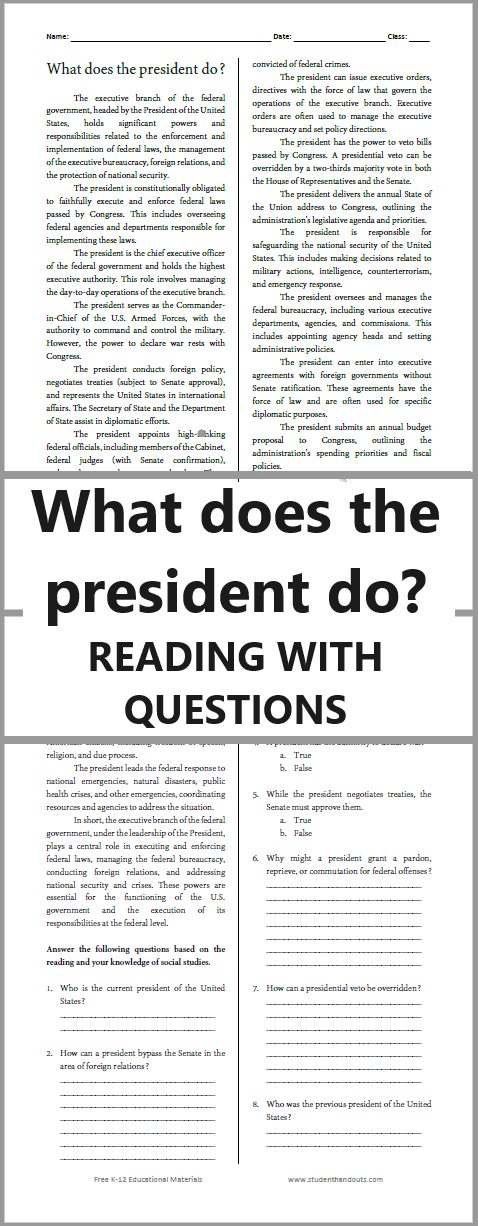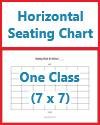| What does the president do? Reading with Questions |
|---|
| www.studenthandouts.com ↣ Social Studies ↣ Civics ↣ Executive Branch of the U.S. Government |
|
What does the president do?
The executive branch of the federal government, headed by the President of the United States, holds significant powers and responsibilities related to the enforcement and implementation of federal laws, the management of the executive bureaucracy, foreign relations, and the protection of national security.  The president is constitutionally obligated to faithfully execute and enforce federal laws passed by Congress. This includes overseeing federal agencies and departments responsible for implementing these laws.
The president is constitutionally obligated to faithfully execute and enforce federal laws passed by Congress. This includes overseeing federal agencies and departments responsible for implementing these laws.
The president is the chief executive officer of the federal government and holds the highest executive authority. This role involves managing the day-to-day operations of the executive branch. The president serves as the Commander-in-Chief of the U.S. Armed Forces, with the authority to command and control the military. However, the power to declare war rests with Congress. The president conducts foreign policy, negotiates treaties (subject to Senate approval), and represents the United States in international affairs. The Secretary of State and the Department of State assist in diplomatic efforts. The president appoints high-ranking federal officials, including members of the Cabinet, federal judges (with Senate confirmation), ambassadors, and agency heads. These appointments require Senate confirmation. The president has the power to grant pardons, reprieves, and commutations for federal offenses. This authority is used to show mercy, correct injustices, or provide relief to individuals convicted of federal crimes. The president can issue executive orders, directives with the force of law that govern the operations of the executive branch. Executive orders are often used to manage the executive bureaucracy and set policy directions. The president has the power to veto bills passed by Congress. A presidential veto can be overridden by a two-thirds majority vote in both the House of Representatives and the Senate. The president delivers the annual State of the Union address to Congress, outlining the administration's legislative agenda and priorities. The president is responsible for safeguarding the national security of the United States. This includes making decisions related to military actions, intelligence, counterterrorism, and emergency response. The president oversees and manages the federal bureaucracy, including various executive departments, agencies, and commissions. This includes appointing agency heads and setting administrative policies. The president can enter into executive agreements with foreign governments without Senate ratification. These agreements have the force of law and are often used for specific diplomatic purposes. The president submits an annual budget proposal to Congress, outlining the administration's spending priorities and fiscal policies. The president has the authority to declare national emergencies and may access certain emergency powers to address specific crises. The president is responsible for upholding and protecting the civil liberties and rights of American citizens, including freedom of speech, religion, and due process. The president leads the federal response to national emergencies, natural disasters, public health crises, and other emergencies, coordinating resources and agencies to address the situation. In short, the executive branch of the federal government, under the leadership of the President, plays a central role in executing and enforcing federal laws, managing the federal bureaucracy, conducting foreign relations, and addressing national security and crises. These powers are essential for the functioning of the U.S. government and the execution of its responsibilities at the federal level. Click here to print. Answer key is below. Answer the following questions based on the reading and your knowledge of social studies. 1. Who is the current president of the United States? Answers will vary over time. 2. How can a president bypass the Senate in the area of foreign relations? By entering into executive agreements with foreign governments. 3. A president can choose whether or not to enforce laws they dislike. b. False 4. A president has the authority to declare war. b. False 5. While the president negotiates treaties, the Senate must approve them. a. True 6. Why might a president grant a pardon, reprieve, or commutation for federal offenses? To show mercy, correct injustices, or provide relief to individuals convicted of federal crimes. 7. How can a presidential veto be overridden? By a two-thirds majority vote in both the House of Representatives and the Senate. 8. Who was the previous president of the United States? Answers will vary over time. |
 |  |  |  |  |
| www.studenthandouts.com ↣ Social Studies ↣ Civics ↣ Executive Branch of the U.S. Government |








